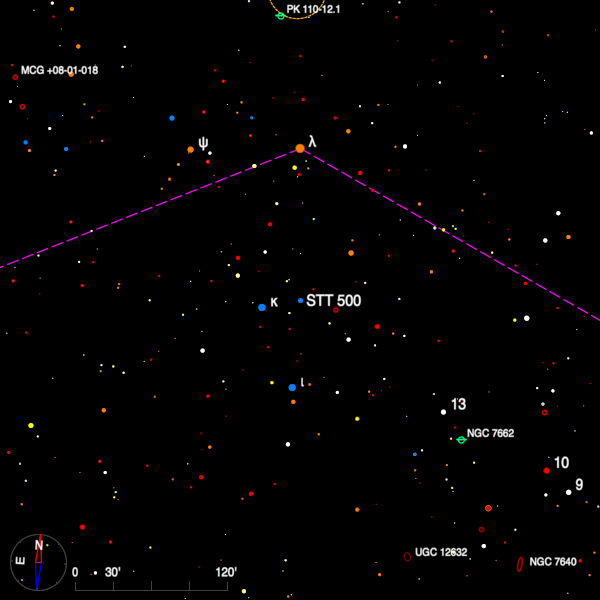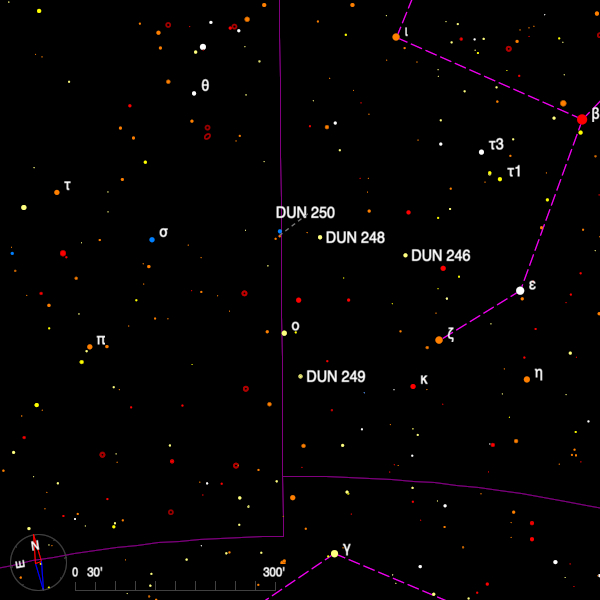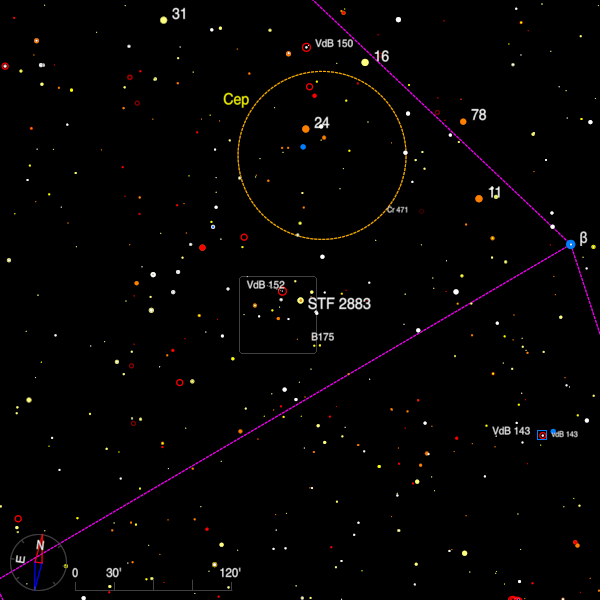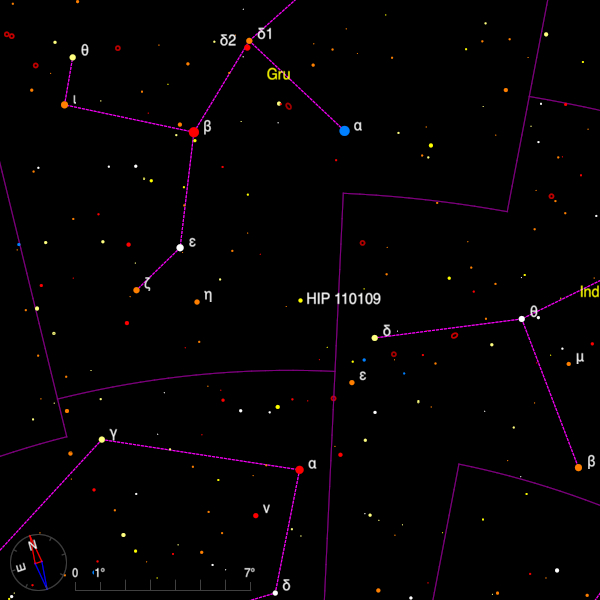Double Star of the Month in Grus
-
October 2022 - Double Star of the Month
Just to the north-east of the Blue Snowball Nebula, NGC 7662, in Andromeda is an asterism of naked-eye stars in the shape of a `Y'. The star at the position where the figure forks is kappa And and just half a degree to the west is STT 500 (23 37 32.53 +44 25 44.5).

A finder chart for the double star STT 500 in Andromeda created with Cartes du Ciel. This is a long-period binary, a preliminary orbit computed in 1981 gives a period of 351 years, and an aperture of 25-cm is probably needed to divide the stars. The V magnitudes are 6.1 and 7.4 and when the binary nature of the system was discovered in 1843 by Otto Struve at Pulkovo, the stars were 0".3 apart and at a position angle of 273 degrees. They are currently separated by 0".4 and they have moved around to a position angle of 21 degrees.
Gaia DR3 has an entry for the brighter star but no data on parallax and proper motion. The Hipparcos satellite gave a distance of 807 light-years but with a formal error of 104 light-years. At a distance of 118" and a position angle of 334 degrees is a more distant star of V = 11.0.
DUN 249 (23 23 54.52 -53 48 31.5) is located in the extreme SE corner of Grus and about 2.5 degrees due east of kappa Gruis. Like many other pairs in the Dunlop catalogue this is a wide and bright pair, easily seen in the smallest of apertures. I measured it using the 26.5-inch refractor at Johannesburg in 2016 when the position angle and separation were 211 degrees and 26".4 respectively.

A finder chart for the double star DUN 249 in Grus created with Cartes du Ciel. Gaia DR3 gives distances of 408 and 494 light-years for the stars which, nevertheless, have very similar proper motions. The errors on the parallaxes nowhere near overlap so it seems that these stars are not connected physically.
Head 3 degrees north and there is a line of DUN pairs stretching along the 51st parallel of south declination including DUN 246, DUN 248 and DUN 250.
Bob Argyle - Double Star Section Director
-
September 2021 - Double Star of the Month
STF 2883 (22 10 38.8 +70 07 57.2) is located in the pentangle of Cepheus, about 3 degrees following beta Cephei, which is itself a fine pair (see this column for Sept 2012).

A finder chart for the double star STF 2883 in Cepheus created with Cartes du Ciel. This pair was somehow missed in my early survey carried out in the late 1960s, probably because of its high declination. It also eluded the elder Herschel and only made it into his final double star catalogue of 1822 as H N 121. It was subsequently observed by South and John Herschel and they noted the stars were white and blue with the colours very decided. I measured it with the Cambridge 8-inch in 2003 (253, 14".4) and at the time I noted another fainter and wider pair about 15 arc minutes south-west (7.9, 8.1, 207 degrees, 66").
STF 2883 is almost certainly a long period binary. The distances as they appear in Gaia EDR3 are almost identical and the proper motions are similarly equal. The stars lie 106.29 light-years away. This is a nice pair for the small telescope with the stars shining at magnitudes 5.6 and 8.6.
HIP 110109 (22 18 15.6 -53 37 38) is a Sun-like star of magnitude 5.4 located in the south-western corner of Grus and which can be found six degrees due north of alpha Tucanae.

A finder chart for the double star HIP 110109 in Grus created with Cartes du Ciel. During the period in the late nineteenth century when observers from Harvard were site-testing at Arequipa in Peru, they discovered a number of new double stars and this star appeared in that list (HDO) as number 298. When first observed the magnitude 9.7 companion was 2".5 distant in position angle 10 degrees but since then the stars have closed and the last measurement in 2015 found the companion at 10 degrees and 1".8.
Hipparcos found both stars to have the same distance (45 light-years) within the admittedly large errors on each parallax.
Bob Argyle - Double Star Section Director
-
October 2017 - Double Star of the Month
William Sadler Franks was an astronomer who assisted Isaac Roberts at his observatory in Crowborough from 1892 to 1906 and then went on the act as astronomer for Mr. F. J. Hanbury in East Grinstead from 1908.
One of his interests was in the micrometrical measurement of wide double stars and he undertook to re-observe all the pairs in the Dorpat and Pulkova appendix catalogues which are usually marked by the characters OΣΣ, Σ I and Σ II.
The results, which were achieved with a Cooke telescope a little over 6-inches in diameter and a filar micrometer, appear in eight lists published in Monthly Notices of the RAS between 1914 and 1920.
During the course of this work he swept up a number of new, wide systems. The WDS catalogue contains the pairs FRK 1 to FRK 13 but in fact there are only 10 pairs in this list now left in the catalogue.
FRK 11 (22 30 06.50 +49 21 23.1) lies in Lacerta just over 1 degree south and slightly preceding α Lac. The primary is V = 6.7 and it is a K2 giant star. The companion, which is optical but also a K giant, is currently 67 arc-seconds distance in PA 91 degrees and is considerably fainter - magnitude 10.7. The interest attached to this pair is that the brighter star is an RS CVn binary with a period of 17.76 days and an amplitude of 0.12 in V.
In the south-eastern corner of Grus are a number of double stars discovered by James Dunlop at Parramatta.
Three degrees east of ε Gruis is DUN 246, a fine pair of yellow stars of magnitudes 6.3 and 7.1 currently 9 arc-seconds apart in PA 254 degrees.
Move a further two degrees east and you will alight on DUN 248 (23 20 50.13 -50 18 23.0). The stars in this case are magnitude 6.2 and 6.6 and measured by me at 211.4 degrees and 16".90 in late 2013, but in 1947, Richard Rossiter discovered that the A star was a close pair.
At that time the separation was 0".5 but in the 70 years since the separation has widened and the stars are now 1".3 apart. The companion is magnitude 8.9 so it will need probably 25-cm to see this close pair.
Bob Argyle - Double Star Section Director
-
October 2015 - Double Star of the Month
STF 2816 (21 38 57.62 +57 29 20.5) which sits within the cluster Trumpler 37 (and the HII region IC 1396) and is a multiple star with three stars visible to the small aperture.
AC are stars of magnitudes 5.7 and 7.5 separated by 12" in PA 120 and with little motion visible. The primary is a very hot star of spectral type O6f. Some 20" away in PA 338 is a further star (D) of magnitude 7.8. This in turn has a 13.2 mag comes at 351 degs and 55". In 1889, using the Lick 36-inch refractor, S. W. Burnham added a 13.3 star to A at a distance of 1".7. At the highest angular resolutions A is double again with a companion at a distance of 0".1 and it is also a double-lined spectroscopic binary with a period of 3.7 days so it seems likely that this is a very close triple.
For the binocular user, the stars that make up the wide pair of pi1 and pi2 Gruis make a splendid sight. They lie about halfway between alpha and beta Gruis and a degree north of that line.
The brighter of the two is pi1 Gru (22 22 44.2 -45 56 52.61) at V = 5.62. This is a F3 star which is a giant or sub-giant and which has a large annual proper motion. Its distance is correspondly small - 130 light years. Some 269" east and slightly north is pi2 at V = 6.55 but extremely red in colour. It is a member of the rare spectral class S and has a (B - V) index of 2.1. Looking at it on the POSS images it appears slightly brighter than pi1 but when the 2MASS survey image is examined, its overwhelmingly bright image practically obliterates that of its companion.
Both stars are double and both were discovered by Robert Innes. Pi1 is I 135 - the companion is a GO dwarf, magnitude 10.7, distant 2".5 in PA 200, although observations of the system with VLTI show a spiral-shaped arc of emission which may be due to orbital motion of this dwarf and indicates the possibility of a third star, much closer in with a period of less than 10 years. Pi2 is I 382 where the 11.4 mag companion has moved from a separation of 4".6 to 11" over the course of a century, due to the large motion of A.
Bob Argyle - Double Star Section Director
-
October 2014 - Double Star of the Month
About 2 degrees north of iota Cephei can be found the pair STF2947 (22 49 00.68 +68 34 12.2). This neat 4".6 pair can be well seen in 15-cm and the magnitudes are 6.9 and 7.2. Sissy Haas notes that iota is golden colour and STF2947 is a pair of yellowish-peach stars. Hipparcos does not appear to have observed this pair but it does appear in the 1952 Yale Catalogue of Parallax where the distance is given as 120 light years but with an uncertainty of 20%. A third star of magnitude 12.5 can be found at 208 degrees and 121" but it does not share the space motion of the close pair. About two degrees south is STF2948 (7.3, 8.6, 4 degs, 2".6))
Theta Gruis (23 06 52.77 -43 31 17.2) is the brighter component of the very wide pair SHY 366. The nomenclature refers to Shaya and Olling who in 2010 made a study of wide pairs in the Hipparcos catalogue for which the proper motions were very similar. In the case of Theta Gruis they concluded that the likelihood that A and C (mags 4.5 and 7.8, 292 degs, 159") were physical was 100%. The distances to A and C are respectively 131.9 and 130.4 light years. Jacob then discovered that A itself was a close pair with star B of magnitude 6.6, being found at 114 degrees and 1".5 in 2009. William Stephen Jacob was an Army engineer with a deep interest in astronomy an during secondment on duty in India in the 1840s managed to make some observations of double stars. He used the 6.3-inch Lerebours refractor at Madras to make some micrometric measurements and also discovered a number of new pairs. The WDS contains 24 pairs bearing his discovery number which also includes the binary JC 8 and the Antares lookalike-pair 21 Sgr = JC 6 (see the column for Sep 2008).
Bob Argyle - Double Star Section Director
-
September 2014 - Double Star of the Month
H 1 48 (21 13 42.46 +64 24 15.1) is a very rare example of one of William Herschel's close discoveries which retains its original designation instead of being absorbed into the catalogue of F. G. W. Struve, as many of his pairs were. It is also remarkable as being a fairly short period system which has both high eccentricity and high inclination. It is characterized by periods of rapid angular motion at very small separations and then stretches of decades when it is visible to the medium aperture. The brightness of the stars (7.2 and 7.3) means that it is never an easy object in small telescopes but may well be visible in 15-cm after 2020 or so when the separation slowly increases to 0".9. The ephemeris for the 81.7 year orbit by Marco Scardia and colleagues gives a separation of 0".72 and PA 243° for 2015.0. The pair can be found 1 deg south preceding 6 Cephei which is, in turn, 3 degrees north of alpha Cephei.
BSO 15 (21 48 15.75 -47 18 13.0) is a naked eye star in Gruis about 4 degrees preceding and slightly south of alpha. It was found to be double by Thomas Brisbane in the early 1830s. The primary is a GO dwarf of V = 5.6. Hipparcos places this star at a distance of only 52 light years and as a consequence it has a fairly substantial proper motion of almost one-third of an arc second per year. The mag 8.8 companion is not connected and is being rapidly left behind by the proper motion of A. The pair was first accurately measured by John Herschel in 1836 when he found B at a separation of 30.3" in PA 14°. Last year the writer measured the pair again and found a distance of 78".9 in PA 350.2°, in good agreement with the prediction given in the USNO Linear Elements Catalogue. This pair has not been observed by either Hartung or Haas and the writer didn't note any significant colour in either component. Recent observations by the infra-red Herschel telescope show there is a large proto-planetary dust ring around this star stretching from about 100 to 180 AU.
Bob Argyle - Double Star Section Director
-
Double Star of the Month - September 2011
In this series of short articles, a double star in both the northern and southern hemispheres will be highlighted for observation with small telescopes, with new objects being selected for each month.
kappa Pegasi (21 44 36.4 +35 47 39.5) is a famous visual binary, having been discovered by Burnham in 1880 using the 18.5-inch refractor at Dearborn. Apart from observations by the Greenwich double star observers around the turn of the century, and later at Herstmonceux and Christopher Taylor with his 12.5-inch it has eluded attempts at resolution from the UK. The separation barely exceeds 0".2 at any point in the 11 year orbit. Of more interest to the smaller aperture user is the Struve companion (STF 2824) which sits about 14" distant at PA 288. The writer has measured it with a 20-cm OG but, it has to be said, with some difficulty, owing to the faintness of B. The WDS gives 10.8 with the primary at V=4.1.
pi Gruis (22 22 44.2 -45 56 53) would be a naked-eye pair if it were a little brighter. There are 2 stars of mags 6.5 (pi 1) and 5.6 (pi 2). Both are double stars in each case with companions about 4 magnitudes fainter and 3 to 5 arc seconds apart and both were discovered by Robert Innes. The easier of the two is pi1 (I 135) which also has the distinction of being a member of the rare S class of stars and varies between visual mag. 5.8 and 6.4. Hartung notes that the primary is bright orange. Whilst the binary nature of pi1 is not yet clear, pi 2 (I 382) seems to be physically connected. For the galaxy observer the edge-on spiral IC 5201 is about 15' SW of pi 2.
Bob Argyle - Double Star Section Director
-
Double Star of the Month - October 2009
In this series of short articles, a double star in both the northern and southern hemispheres will be highlighted for observation with small telescopes, with new objects being selected for each month.
Perhaps to be classed more as a small cluster than a multiple star the system of 8 Lac (22 35 52.3 +39 38 04) was first noted by Herschel.
They form an arch
was the comment he added in the Philosophical Transactions paper in 1784. The small telescope user can see four components with relative ease: A=5.7, B=6.3, C=10.4 and D=9.1. AB is 185 degrees, 22".2, AC is 168 degs and 48".3 and CD is 116 degs and 42".4. A fifth star I, is mag 11 and 228 degs and 9".7 from D. It was found by T. Espin in 1906. The remaining four components according to the WDS (where it is known as STF 2922) are either very faint, very close or extremely distant.Hipparcos had great trouble with the distance to stars A and B which were the only two that it observed, but it seems that they are so remote that the parallax is to all intents too small to measure and means that the main stars are before at least 2000 light years away. The spectral types are early to mid-B so they are probably hot young stars. Thus might indicate that the predominant colour would be white. Chambers makes A and B white but C greenish and D blue. Webb notes that A and B might be tinged with yellow but also makes D blue.
DUN 246 ( 23 07 14.8 -50 41 12) lies in a
thinly sprinkled star field
according to Ernst Hartung. The stars are magnitudes 6.3 and 7.1 whilst the separation has been slowly decreasing since discovery by Dunlop in 1825. The current position is about 255 degs and 8".7 and the similar proper motions of both stars indicates a long period binary system. A pair of late type dwarfs is reflected in Hartung's colours of yellow for each component. More recently Gould with 35-cm noted the colours are both pale yellow.Bob Argyle - Double Star Section Director